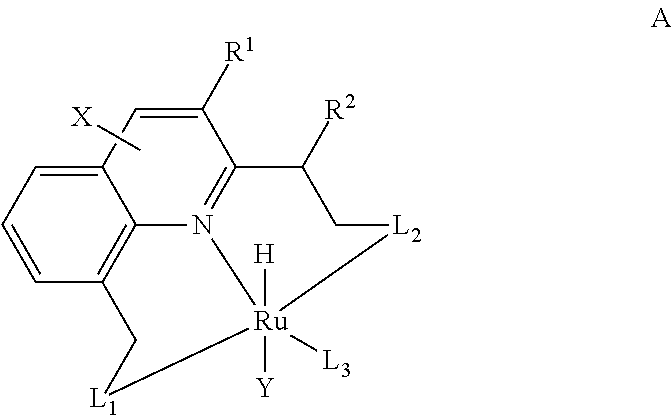Process for preparing amines from alcohols and ammonia
a technology of alcohols and ammonia and amines, applied in the field of new amine preparation processes, can solve the problems of cumbersome process even for small-scale syntheses, environmental protection, and difficult selective synthesis, and achieve excellent atom-economy, no waste, and high atom-economy
- Summary
- Abstract
- Description
- Claims
- Application Information
AI Technical Summary
Benefits of technology
Problems solved by technology
Method used
Image
Examples
example 1
Preparation of Acridine-Based Pincer Complex RuHCl(A-iPr—PNP)(CO) 1
[0116]The novel, acridine-based pincer complex RuHCl(A-iPr—PNP)(CO) 1 was quantitatively prepared by reaction of the new electron-rich tridentate PNP ligand 2 with RuHCl(PPh3)3(CO) in toluene at 65° C. for 2 h (Scheme 5). 31P {1H} NMR of 1 shows a singlet at 69.35 ppm. The 1H NMR spectrum of 1 exhibits a triplet resonance at −16.09 ppm for Ru—H. The “arm” methylene protons give rise to two double triplets at 3.50 and 5.24 ppm (2JHH=12.8 Hz, 2JPH=3.7 Hz). One singlet resonance for C9H of the acridine ring appears at 8.15 ppm, representing an up field shift of 0.46 ppm relative to the corresponding proton of the ligand 2 (8.61 ppm), suggesting diminished aromaticity of acridine on complexation with ruthenium. The structure of complex 1 was determined by a single-crystal X-ray diffraction study, which reveals a distorted octahedral geometry around the ruthenium center (30). Upon complexation acridine looses its planarit...
example 2
Synthetic Methods
General Experimental
[0118]All experiments with metal complexes and phosphine ligands were carried out under an atmosphere of purified nitrogen in a Vacuum Atmospheres glovebox equipped with a MO 40-2 inert gas purifier or using standard Schlenk techniques. All solvents were reagent grade or better. All non-deuterated solvents were refluxed over sodium / benzophenone ketyl and distilled under argon atmosphere. Deuterated solvents were used as received. All solvents were degassed with argon and kept in the glove box over 4 Å molecular sieves. Most of the chemicals used in catalysis reactions were purified by vacuum distillation. However when commercial grade reagents were used comparable yield of products were obtained. Ultrapure water obtained from Barnstead NANOpure DIamond™ water purification system was used for catalysis reactions in water. 4,5-bis(bromomethyl)acridine (31) and RuHCl(CO)(PPh3)3 (32) were prepared according to literature procedures.
[0119]1H, 13C and ...
PUM
| Property | Measurement | Unit |
|---|---|---|
| temperatures | aaaaa | aaaaa |
| temperature | aaaaa | aaaaa |
| temperatures | aaaaa | aaaaa |
Abstract
Description
Claims
Application Information
 Login to View More
Login to View More - R&D
- Intellectual Property
- Life Sciences
- Materials
- Tech Scout
- Unparalleled Data Quality
- Higher Quality Content
- 60% Fewer Hallucinations
Browse by: Latest US Patents, China's latest patents, Technical Efficacy Thesaurus, Application Domain, Technology Topic, Popular Technical Reports.
© 2025 PatSnap. All rights reserved.Legal|Privacy policy|Modern Slavery Act Transparency Statement|Sitemap|About US| Contact US: help@patsnap.com



